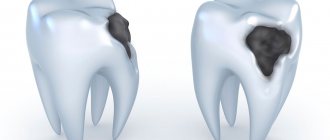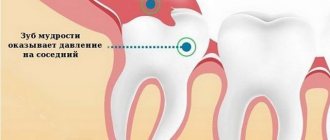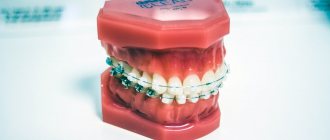Scary baby teeth worry the parents of many children; caries is to blame. In the mouths of some adults you can see the same picture, since no one is immune from the effects of cariogenic bacteria. Therefore, the condition of tooth enamel must be constantly monitored: starting from childhood and continuing into adulthood. And if you have the slightest suspicion of the development of caries, you should immediately visit the dentist, because in the early stages the disease is treated faster and easier.
Bad teeth in a child: reasons
A child’s baby teeth rot for various reasons.
Some are impossible to influence, others can be easily eliminated by dentists and caring adults. Most often, destruction of the enamel, and subsequently the coronal part of the primary occlusion units, is facilitated by:
- Disorders of intrauterine development of a child. Developmental pathologies are formed due to maternal toxicosis, non-compliance with nutritional recommendations, and the use of potent medications.
- Early birth of the baby. Prematurity of a baby indicates incomplete formation of internal systems - in particular, weak thin enamel of baby teeth.
- Antibacterial therapy administered to a child in the first year of life.
- Poor hygiene. Lack of systematic cleaning after the first tooth erupts, improper care, and inadequate parental control.
- Unbalanced child nutrition. Predominance of flour and sweets in the menu, lack of fermented milk and dairy products, hard fruits and vegetables.
- Reduced immunity. Congenital or due to a lack of vitamins in the diet.
- Diseases of the gastrointestinal tract, dysbacteriosis.
- Diseases of the endocrine system - diabetes mellitus.
- Previous infections - ARVI, chicken pox, scarlet fever.
- Pathogenic microflora entering the baby’s mouth from the outside. If family members have the habit of licking the baby’s spoon or pacifier, or kissing the baby on the lips.
- Poor ecology is a significant external factor that negatively affects the condition of the child’s teeth and general well-being.
- Heredity - parents or grandparents have bad teeth.
- Mechanical injuries, external damage to tooth enamel - cracks, small chips.
Why does bone tissue decrease when teeth are missing?
Very often, when planning dental restoration using implants, we are faced with a deficiency of bone tissue, which is accurately detected during computed tomography:
Let's figure out what it is and why it happens
Let's start with the fact that bone is a living tissue, with its own laws of life. In the case of implantation, we are talking about the alveolar bone, that is, the bone of the alveolar process - the bone where the roots of the teeth are located. And when we talk about bone deficiency, we are talking about a deficiency of the alveolar bone. This bone provides support and stability to teeth. Its entire structure is aimed at stabilization.
And when teeth are lost, the need for this bone disappears and its resorption or resorption occurs. Loss of alveolar bone can also occur with preserved teeth due to periodontitis. The loss of bone tissue increases many times over when using removable dentures, since the denture exerts unusual pressure on the gum and bone, pressure for which the bone was not “designed” to bear. As a result, we are faced with a situation where the bone - where the implants can be installed - is missing or insufficient.
An example of what can happen to the bone tissue of a patient who had a tooth removed more than 15 years ago and did not go to the doctor only because he was afraid of the sinus lift procedure is shown in detail in my article “He was afraid of the sinus lift and waited... 15 (!) years"
We will talk about methods of treating adentia in the next article.
How to determine if a child has bad baby teeth
A child's rotten front teeth are immediately visible. These are dark or yellow spots of enamel, reddened gums, and damaged edges. But sometimes decay begins on the distant teeth - molars, premolars, and then you need to focus on indirect signs.
The fact that a child is growing bad teeth is indicated by:
- complaints of pain and discomfort - reaction to toothpaste, hot or cold foods;
- unpleasant odor from the baby’s mouth - putrid, pungent;
- change in enamel color - the appearance of dark stripes, yellow or dark spots;
- development of dental diseases - caries, pulpitis.
Any of the listed factors indicates the need for consultation with a pediatric dentist - a full diagnosis and timely treatment.
What to do with black teeth?
Many people are afraid to go to the dentist because they think: since the tooth has turned black, it will definitely be removed. This is wrong. A change in color is not an indicator for removal. On the contrary, modern technologies make it possible to save even almost destroyed teeth. What awaits you is not deletion, but the following procedures:
- General inspection.
First of all, the doctor will determine why black spots have appeared or the tooth has darkened completely. - Professional oral hygiene
with comprehensive cleaning, selection of toothpaste and brush. This procedure is recommended for those whose teeth have become darkened due to poor care or poor nutrition. - Removing damaged or caries-affected tissues
, changing fillings, treating canals. In this way, the consequences of caries are removed. - Installation of veneers, lumineers, intracanal whitening.
These procedures are recommended for those whose front teeth have turned black (due to mechanical stress or caries). - Removal
is a last resort. Now doctors are trying to use the most gentle methods to restore teeth.
Keeping your teeth healthy is important because your smile affects the impression you make on other people. Therefore, it is advisable to follow a special “white” diet, which excludes staining of the enamel with different products, brush your teeth properly, choosing a brush and toothpaste as recommended by your doctor, and regularly visit the dentist for preventive maintenance.
Stages of decay of children's milk teeth
A child’s bad teeth almost always mean caries. The disease is distinguished by the type and depth of tissue damage. Dentists highlight:
- Initial and superficial caries is the primary destruction of the enamel, manifested as white spots.
- Visible carious lesions are medium and deep caries. Teeth rot quickly and stains develop into cavities. The child begins to experience pain. An unpleasant odor appears from the mouth.
- Circular caries is the circular destruction of enamel and dentin near the gums. If left untreated, the tooth breaks and rots further to the root.
In particularly advanced situations, damage covers an increasingly larger volume of tissue, leading to serious pain and loss of the milk unit.
Caries - prevention, treatment, photo
Caries is a disease associated with damage to the hard tissues of teeth, which leads to the loss of the enamel’s ability to accumulate fluoride and other minerals and the subsequent formation of voids. Caries is caused by bacteria that feed on glucose. They accumulate on the surface of the enamel in places where it is softened or damaged. Symptoms of caries:
- the appearance of whitish spots on the enamel, which begin to darken over time;
- feeling of roughness of tooth enamel, chips, scratches, small holes on it;
- unpleasant and painful sensations when eating hot, cold, sweet or sour foods.
Stages of disease development
Stage of white (fissure) caries
Damage occurs to the chewing surface of the lateral teeth. The enamel gradually dissolves, which leads to the destruction of dentin and darkening of the spots. It is difficult to notice white spots on the enamel on your own, so the dentist uses methylene blue (a special coloring agent) for diagnosis. Using the remineralizing therapy method makes the process reversible and prevents further leaching of calcium.
Stage of superficial caries
If preventive measures have not been taken to restore the mineral balance of the enamel, the disease begins to progress. Irreversible changes occur in the structure of the enamel and the structure of its prism. The peculiarity of superficial caries is damage only to the surface of the tooth without penetration into the tissues. Black or brown spots appear, and a white (yellow) coating forms more actively. If caries is concentrated at the neck of the tooth, pain may occur when eating cold, hot or sweet food. Consequences: infection penetrates into the deep layers of the tooth.
Stage of middle caries
It is characterized by an increase in the size of black and brown spots, the occurrence and intensification of pain symptoms. At this stage, it is imperative to contact a dentist, otherwise... Consequences: there is a high risk of damage to the dental nerve.
Stage of deep caries
The carious process penetrates deep into the dentin, which leads to increased sensitivity of the dental nerve to hot/cold food. The size of the dark spots increases. Consequences : if you do not put a filling at this stage, then after some time inflammation of the dental pulp (nerve) will occur.
Bad teeth in a child: how to treat
Decay of baby teeth can be stopped. Especially if the parents quickly assessed the threat and brought the child to the children's dental clinic. Treatment options are different:
Remineralization of tooth enamel
The doctor will apply a special gel to the baby teeth, which contains minerals to strengthen the teeth. Usually it is calcium, phosphorus, fluorine. The substances will restore the enamel structure at an early stage of destruction, but if the teeth are already rotting, the dentist will select a different treatment.
Sealing
Cleaning out carious cavities and then installing a filling. The preparation method is selected according to the patient’s age. Modern dental clinics treat teeth without a drill - using the ICON method, as well as using classical methods.
Ozonation of teeth
A method of disinfecting destroyed cavities followed by filling, when ozone is used to eliminate pathogenic microflora. The treatment has proven itself to work with children's rotten teeth, but is only suitable for moderate decay.
Laser therapy
The disinfectant effect of a laser beam is an excellent way to disinfect a small cavity and remove bacterial microorganisms in the mouth of a young patient. Suitable for the treatment of moderate caries of primary teeth.
Removal
A radical method of dealing with rotten teeth of a child. Used when it is impossible to carry out therapy and save teeth.
Rodikova Tatyana
When parents are interested in why their child has bad teeth, I first of all ask about nutrition. Almost all children today eat sweets, chips, and drink soda without restrictions. Of course, this negatively affects the teeth. The second common reason is heredity. Congenital diseases and medications are less likely to damage teeth.
Why treat baby teeth?
Rotten baby teeth do not always attract the attention of parents. Especially if the pathological processes are painless and do not bother the child. Adults think that when the bite changes, the bad teeth will disappear by themselves, and instead of rotten teeth, normal molars will grow. Dentists warn about the fallacy of such a misconception.
Rotten milk teeth are:
- damage or destruction of tooth germs - a high risk that the root units will grow sick or not appear at all;
- early loss of primary occlusion units - leads to displacement of existing teeth, the appearance of crowding, and the formation of a pathologically abnormal bite;
- an ugly smile, an unaesthetic appearance - the appearance of complexes due to appearance in young children, decreased contact with peers, uncertainty, isolation;
- deterioration of diction - rotten, breaking teeth interfere with the correct movements of the tongue during speech, leading to a lisp, burr;
- gradual spread of infection - damage not only to the surface of the teeth, but also to the pulp, development of pulpitis, the appearance of an abscess, as well as a tendency to ENT diseases and gastrointestinal diseases.
Consequences
Rotting teeth primarily brings physical discomfort, inconvenience and pain to a person.
In advanced situations, destructive processes lead not only to infection of the entire oral cavity, but also to tooth loss . It is possible to develop diseases of the skeletal system and the appearance of polyarthritis.
Infection and bacteria-contaminated blood spread throughout the body, reducing immunity and causing disturbances in the functioning of the stomach, heart and even brain damage.
Such problems are especially dangerous for children and pregnant women. During the period of growth and development, pain and lack of microelements interfere with the normal formation of a healthy body of both the teenager and the fetus in the womb. The immune system is weakened.
How to prepare your child for an orthodontic appointment
The initial appointment with an orthodontist takes place without any preparation. The child just needs to brush his teeth and eat beforehand. The latter is desirable, as it will help reduce salivation and facilitate the examination procedure. The child should also be told about the doctor’s specialization. In simple words, explain who this pediatric orthodontist is and what he treats.
An orthodontic examination is a painless procedure. It does not cause fear or discomfort in the baby, but it helps to identify deviations in the development of the dentition as early as possible.
Soldatenkova Alina
Typically, the removal of decayed milk teeth involves the extraction of several units at once. At Azabuka, we recommend performing this procedure under anesthesia or sedation. It is completely safe for the child, and most importantly, it does not leave traumatic, unpleasant memories in the child’s memory.
Other causes of enamel darkening in children
Rotten baby teeth in a child look different in the photo. Usually these are black spots, lumpy enamel, deformed crowns - unpleasant, ugly, even creepy. But an unaesthetic appearance does not always indicate rotting. Sometimes the reasons lie in other diagnoses or pathologies:
- black plaque;
- enamel hypoplasia;
- abnormalities in tooth shape.
Black plaque - stains on baby teeth
Dark spots on teeth are not always tooth decay. It could also be:
- Priestley's plaque - appears due to the increased activity of certain bacteria that secrete a black pigment. The defect is aesthetic, but dentists advise cleaning the enamel from plaque, since it can prevent caries or other dental diseases.
- Dark deposits due to taking iron supplements are an aesthetic problem, which professional cleaning helps to cope with.
Dark pigmentation is also caused by dysbiosis, lack of calcium, and taking antibiotics. Plaque is removed using gentle dental cleaning methods, returning the enamel to its natural whiteness.
Enamel hypoplasia and tooth shape abnormalities
Hypoplasia manifests itself as a change in the structure and color of the enamel and is not a carious lesion. Is it congenital or acquired? In the case of systemic hypoplasia, the shape of the dentition units may also be affected. Externally, the pathology manifests itself as:
- an altered line of the tooth edge is a natural deformation, and not due to rotten teeth;
- barrel-shaped crowns, cone-shaped - due to changes in the tooth at the dentin level;
- spots on the tooth surface of different sizes and shades - altered enamel thickness, insufficiently developed tissues.
For isolated manifestations, hypoplasia is not treated. In case of severe defects in baby teeth, the doctor will suggest remineralization and filling of the affected areas.
Treatment methods
Since the destruction of crowns can be caused by a wide variety of reasons, the stages of treatment are drawn up only after they have been identified. The entire process is based on the principle of complexity.
Therapy for rotten crowns includes the use of medications, dental surgery and folk remedies.
Medications
When teeth are rotting, medications are used that reduce the number of pathogenic bacteria. A good effect is obtained by rinsing the mouth with an aseptic solution of chlorhexidine gluconate .
In addition, fluoride treatment using special pastes or rinses. To reduce swelling of the gum tissue and partially relieve pain, use paracetamol, aspirin or ibuprofen .
When taking these drugs, it should be borne in mind that aspirin causes Reye's syndrome and is therefore contraindicated in people under 20 years of age. The complex provides general strengthening therapy with the prescription of vitamins. It is possible to add treatment with antibiotics prescribed by the doctor.
Dental intervention
For rotten teeth, the main therapy is to eliminate the source of infection. To do this, the dentist must treat the pathological areas in order to stop further destruction.
As a rule, this procedure follows a standard scheme:
- administration of application or infiltration type anesthesia;
- crown preparation;
- if the tooth is deeply damaged, then the canals are ground down to remove rotting tissue;
- removal of nerves and treatment of canals;
- filling.
If the degree of destruction is high, restoration work may be necessary. After the procedures, the dentist makes additional prescriptions: antibiotics, diet , etc.
Folk remedies
Photo: Chinese lemongrass
Traditional medicine is very diverse. Among them there are those that will help alleviate the symptoms of rotting. The most effective can be considered products based on plants, which can be easily purchased at any pharmacy:
- tea based on Chinese lemongrass (bark) . After brewing 1 tbsp. spoons 0.5 l. Boiling water must be drunk at least three times a day. This will slightly reduce inflammation and temporarily relieve pain;
- horsetail has the same effect , which must be taken in powder form at least twice a day. This plant strengthens tooth enamel well;
- an infused mixture of fennel, mint and horseradish root helps fight inflammation and soothe irritated soft tissue, which is especially important after dental procedures. To do this, you need to rinse your mouth with tincture three times a day;
- a decoction of rosemary, bay leaf and cinnamon is also used for rinsing . This product is an excellent antiseptic.
In order not to aggravate the situation, you should not self-medicate. In all cases, comprehensive treatment of rotten teeth should be carried out under the strict supervision of a specialist.
We have collected reviews and prices about laser teeth whitening in a separate publication.
In the following review you will read about the treatment of oral leukoplakia.
Here: https://zubovv.ru/detskaya-stomatologia/d-zubi/prorezyivanie-z/sroki-i-nyuansyi-molochnyih.html - a table with the timing of the eruption of baby teeth in children.
How to protect your child's teeth
Among the main preventive measures for the preservation of teeth in children of any age are:
- Maintaining oral hygiene to prevent plaque formation - timely care, selection of toothbrushes and toothpastes according to age, professional cleaning using gentle methods.
- Good nutrition - creating a varied menu that will include yoghurts, kefir, cheeses, vegetables and fruits.
- Selection of a vitamin complex according to age - independently or after consultation with a pediatrician.
- Timely visits to the dentist - pediatricians recommend coming for scheduled appointments every 4-6 months. This helps to identify caries and enamel destruction at an early stage and save teeth from serious problems.
- Fissure sealing - smoothing the lumpy surfaces of molars and premolars to reduce the risk of caries and rotting of distant units.
Rodikova Tatyana
Parents often have to explain: it doesn’t matter when the child’s bad teeth appeared - at 3 years old or at 7 years old - they need to be treated. Waiting until they fall out on their own is a big risk. Fortunately, in most cases the explanations work and we begin treatment. It's nice to see how a child's face changes when he sees beautiful, even, snow-white teeth in the mirror - instead of rotten and black ones.
It is also worth carefully monitoring the mechanical integrity of the teeth, since any crack or chip is a potential threat to the child’s dental health.
The health of children is the concern of parents. Poor heredity, diseases, premature birth indicate the need for careful monitoring of the condition of teeth - timely prevention and treatment. If everything is done correctly, then the child will not have rotten teeth, but only a joyful and beautiful smile.
Causes of the rotting process
The main factor in the occurrence of putrefactive processes is the formation of caries . Most often, the damage begins from the crowns.
In the first stages, yellow spots and a large number of deposits form on the enamel. After which the upper layer of the tooth softens, the enamel becomes porous, and an intensive process of decay begins.
If it is not stopped in time, then nearby crowns are also affected. Putrefactive processes can be triggered by a number of reasons, which can be divided into three groups.
Local
Local causes include factors that directly affect tooth enamel and oral microflora. One of the primary local factors is smoking .
The tars contained in cigarettes remain on the enamel, creating favorable conditions for the proliferation of pathogenic microbes.
In addition, nicotine disrupts blood circulation , creating spasms of capillaries in the gum tissue. This disrupts the general metabolic processes of oral tissues and reduces their ability to resist adverse effects.
Alcohol and drugs have the same adverse effect , since their use completely weakens the body’s protective functions.
An unhealthy diet containing a lot of sweet or sour foods can also lead to destruction.
This group also includes inappropriate lifestyle and poor oral hygiene .
Read our review about the benefits of Thai toothpaste.
This article will tell you why a brown coating may form on your tongue.
Here: https://zubovv.ru/krasota-i-uxod/otbelivanie/domashnee/maslo-chaynogo-dereva.html - the nuances of using tea tree essential oil for teeth whitening.
External
These include:
- poor environmental conditions of the area in which a person lives;
- genetic predisposition;
- drinking water deficient in fluoride;
- mechanical damage;
- specifics of professional activity.
Are common
This category of causes includes all general and dental diseases that affect the destruction of enamel, such as:
- hormone imbalance , which often occurs in adolescents during active growth or in pregnant women;
- chronic stomach diseases;
- pathology of periodontal and dental tissue . Particular attention should be paid to cystic formations with purulent contents, as they contribute to the intensive spread of infection to all teeth;
- abnormal liver function;
- infectious diseases;
- pathologies of the upper respiratory tract.
Only a specialist can determine the cause of rotting crowns through a detailed study using modern technologies.











